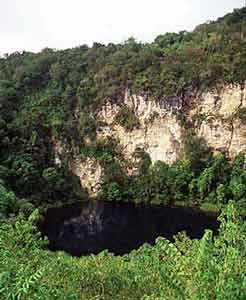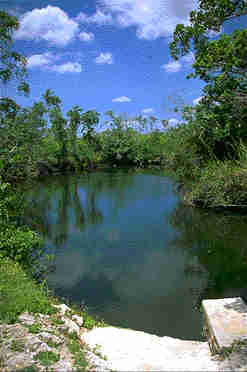
Cenotes are sinkholes
The Yucatan peninsula was originally under the ocean and the region's limestone foundation is fossilized coral beds and ocean floor. There are no above ground rivers in this area, all of the ground water sinks through the porous limestone and travels to the sea in underground rivers. Parts of the limestone weakened over time and collapsed, leaving sinkholes filled with water - a cenote.
During the ice ages, portions of the underground rivers dried up and water dripping through the limestone left mineral deposits in beautiful formations. Decorations - stalactites and stalagmites - formed in the caves and caverns, and were covered with water when the rivers began flowing once again.
Cenotes were sacred to the Maya
 The
Maya used the cenotes for water - both
for drinking and irrigation - and in religious ceremonies. Some of their
cities were built around cenotes or wells dug down to the ground water.
Divers have explored the cenote at Chichén Itzá and have
found offerings the ancient Maya made to the gods. Among them copper and
gold necklaces, pottery, jade beads, and skeletons of both sexes and all
ages.
The
Maya used the cenotes for water - both
for drinking and irrigation - and in religious ceremonies. Some of their
cities were built around cenotes or wells dug down to the ground water.
Divers have explored the cenote at Chichén Itzá and have
found offerings the ancient Maya made to the gods. Among them copper and
gold necklaces, pottery, jade beads, and skeletons of both sexes and all
ages.
The cenotes are still important to the Maya, to make money from tourists. Landowners along highway 307 and the road to Coba who are lucky enough to have a cenote on their land charge tourists a fee to enter. The fees are usually different for people who are swimming, snorkeling and diving - generally between $2-$8 depending on the cenote's popularity.
C enotes
are all different
enotes
are all different
All cenotes are different. Some are below stone overhangs, others are open like ponds. You can take a cooling swim in them, or bring your snorkel gear to see what is below. Casa Cenote is before Tulum and doesn't charge and entrance fee. Car Wash is pictured on the right and is on the road to Cobá. Other popular cenotes are Gran Cenote and Ponderosa. Watch for signs along the highway.
Snorkel, swim or dive
If you are a certified open water diver, you can dive in a cenote cavern with a qualified guide. Anyone can snorkel or swim in a cenote, but you should never dive in a cenote, cavern or cave unless you are certified to do so or have a certified guide with you.
People die from scuba diving in caverns and caves without training. See the National Association for Cave Diving or the cave diving page for more information.
You can see the inside of some caves without getting wet. Just South of Akumal is Aktun Chen, a dry cave you can tour. There is a sign for the cave on the right, and a large sign on the left for DIF, a government run camp.
Take care of your ears after swimming so you don't get sick.

Hidden Cancun and the Yucatan The guide with everything for people who want to rent a car and go out on their own.
[ About Cancun South | Clients | Awards ]
© Property of Cancun South ™ and PlayaLink
SA de CV with offices in Playa del Carmen, Mexico
Cancun South ™ phrase, website content and images not to be used
without permission from the webmaster


